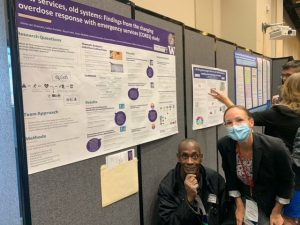In late 2022, a team at the University of Washington wrapped up the Changing Overdose Response with Emergency Services (CORES) study, a collaboration between HSPop, the School of Nursing, and Public Health – Seattle & King County. Researchers collected qualitative data from first responders (police officers, paramedics, and nurses) as well as people who use drugs (PWUD) to glean their attitudes around three different policy ideas: leave-behind naloxone, buprenorphine, and HIV/HCV testing. The second part of the study surveyed how cities across the country are tackling the fentanyl crisis.
In December 2022, the team presented their formal recommendations based on the study findings to King County. They’ve since presented at numerous conferences nationwide, including the Academy Health Annual Research meeting in June 2023. Some members of the “Research with Expert Advisors on Drug Use” (READU) team, who contributed to CORES, are now launching a new five-year study building upon their findings. That study, “Overdose Response Centering Inclusion and Diversity (ORCID),” is funded by a Racial Equity Initiative (REI) grant from the National Institute on Drug Abuse, a research center within NIH. The study will examine how policies implemented in the CORES study have impacted people of color who use drugs in King County.
Recommendations lead to results
Now, several of READU’s recommendations, including those involving naloxone, have at last come to fruition. “Leave-behind” or “take-home” naloxone refers to distributing the drug, which is used to reverse overdoses, to non-medical personnel. As CORES researchers write, “PWUD and their social networks have expressed strong support for the distribution of take-home naloxone to prevent opioid overdoses in their communities.” The study’s interviews found “unanimous support” among PWUD. First responders were similarly supportive of at-home administration and noted that “the sooner naloxone could be administered, the better.”

Fortunately, naloxone is becoming more widely available. Recently, the governor signed a bill requiring all public high schools to stock naloxone, as Seattle Public Schools has for years. Brad Finegood, Strategic Advisor for Public Health-Seattle & King County on Behavioral Health and an advisor to CORES, recommends that naloxone become a staple of families’ medicine cabinets.
CORES’s buprenorphine-related findings are also gaining traction. The CORES report characterizes buprenorphine, a drug used to treat opioid withdrawal, as the “gold standard” for treatment. “Early initiation of buprenorphine-naloxone is associated with lower opioid overdose risk, opioid overdose-related emergency department visits, and reduced health care costs for insured patients with [opioid use disorder],” READU researchers concluded.
In interviews, PWUD were enthusiastic about buprenorphine administered by first responders, noting its convenience and accessibility. Meanwhile, first responders “described buprenorphine as evidence-based, effective, and appropriate for a first responder setting.”
Now, King County has taken note. Seattle Mayor Bruce Harrell has endorsed this approach, and the Fire Department recently began a pilot program to allow paramedics to administer the drug after overdoses. So far this year, the Fire Department has faced an average of 24 overdoses per day.
Jenna van Draanen, a lead CORES researcher who teaches in HSPop and the School of Nursing, said in an interview that an overdose can be a catalyst for treatment. “A lot of people are contacting [emergency medical services] and then later having a fatal overdose. There’s a window of opportunity for intervention where we might be able to connect people with care and avoid a tragic overdose later on,” she explained.
Nothing about us, without us

In addition to its findings, CORES’ innovative study design provides a template for future research. As Finegood explained, the READU team was committed to the ethos of “Nothing about us, without us,” which meant collaborating with PWUD at every step of the process. The READU team, comprised of current and former PWUD, helped draft unbiased interview questions, conduct interviews, and analyze data. The team provided “credibility” and ensured the study did not inadvertently re-stigmatize PWUD, said READU member Cece Wetteman, whose own lived experience battling heroin addiction has made them passionate about harm reduction. They cite the Downtown Vancouver manifesto as an inspiration for their work.
The READU team welcomes recent updates in opioid policy. “[We are] incredibly excited to hear that our work has contributed to this great progress. We’re also inspired by the incredible work from Washington State youth organizers, the folks at the Seattle Fire Department, and the many other people who made these important changes happen,” said the READU team.
“Many members of our team were particularly interested in SB5084 and are hoping we’ll be able to support the rollout of naloxone in schools in some way,” they continued.
Monitoring impact of new policies
What’s next for READU? The team is excited to dig into the equity impacts of these new policies with their new study, ORCID.
“We’re looking forward to continuing our collaboration with community partners toward health equity for people who use drugs,” the team reflected.